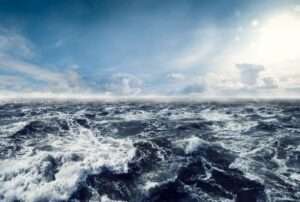Introduction
Ocean Acidification and Forex Markets are emerging as an unlikely but critical link in today’s interconnected world. Ocean acidification occurs when oceans absorb excess carbon dioxide (CO₂) from the atmosphere. This process is accelerating at alarming rates. The chemical shift reduces ocean pH levels and threatens coral reefs, fisheries, and marine biodiversity that millions depend on for survival. Scientists usually highlight the ecological damage, yet the financial consequences are just as severe. The risks are greatest for nations whose economies rely heavily on coastal resources and seafood exports.
When marine ecosystems decline, industries such as fishing, aquaculture, and tourism face immediate losses. For coastal economies, this means shrinking GDP, lower export earnings, and rising trade deficits. These pressures soon spill into financial systems, especially currency markets. Forex traders now factor in climate disruptions, aware that weak industries can destabilise national economies and currencies. A drop in seafood exports from an acidification-hit country, for example, can strain its trade balance and push its currency lower.
This article explores how ocean acidification extends far beyond the environment. It creates risks and opportunities in forex trading that few anticipate. From the vulnerability of small island nations to shifts in global trade flows, the effects of souring seas are beginning to shape forex markets. Traders, investors, and policymakers must see ocean acidification as more than an ecological crisis. It is also a financial force with the power to erode profits and reshape market behaviour.
Understanding Ocean Acidification

Ocean acidification occurs when CO₂ dissolves in seawater, forming carbonic acid. The main causes include burning fossil fuels, deforestation, and industrial emissions.
As CO₂ levels rise, acidity increases, threatening corals, mollusks, and plankton that depend on calcium carbonate. Their decline disrupts marine food webs and economies tied to ocean health.
This complex issue has gained attention from scientists and policymakers worldwide. We will explore its causes, mechanisms, and far-reaching impacts on marine ecosystems.
Causes of Ocean Acidification:
The primary driver of ocean acidification is the increased concentration of carbon dioxide (CO₂) in the Earth’s atmosphere. This rise in atmospheric CO₂ levels is largely attributed to human activities, including the burning of fossil fuels (such as coal, oil, and natural gas), deforestation, and various industrial processes. When these activities release CO₂ into the atmosphere, a portion of it is absorbed by the world’s oceans.
Mechanisms of Ocean Acidification:
The absorption of excess atmospheric CO₂ by seawater triggers a series of chemical reactions within the ocean. This process can be summarised as follows:
- Dissolution of CO₂: CO₂ molecules from the atmosphere dissolve in the surface waters of the ocean.
- Formation of Carbonic Acid: Once dissolved, CO₂ reacts with water (H₂O) to form carbonic acid (H₂CO₃). This chemical reaction is a vital step in the acidification process.
- Release of Hydrogen Ions: Carbonic acid dissociates into bicarbonate ions (HCO₃⁻) and hydrogen ions (H⁺). It is the increase in hydrogen ions that makes the water more acidic.
- Impact on Ocean pH: The increase in hydrogen ions lowers the pH of seawater, making it more acidic. This decrease in pH is often referred to as “ocean acidification”.
Consequences for Marine Life:
Ocean acidification has profound and detrimental consequences for marine life, particularly for organisms that rely on calcium carbonate to build and maintain their protective structures. Here are some key impacts:
- Coral Reefs: Coral reefs, often referred to as the “rainforests of the sea”, are highly susceptible to ocean acidification. The lowered pH disrupts the ability of corals to build their calcium carbonate skeletons. As a result, coral reefs face reduced growth rates, increased vulnerability to physical damage, and a higher risk of coral bleaching events due to elevated sea temperatures.
- Molluscs and Shellfish: Molluscs such as oysters, clams, and mussels, as well as various shellfish species, rely on calcium carbonate shells for protection and as a structural component. Acidification inhibits their ability to form and maintain these shells, making them more vulnerable to predation and environmental stress.
- Plankton: Some species of plankton, including coccolithophores, also utilise calcium carbonate in their cell walls. Changes in chemistry disrupt their growth and can lead to altered species compositions within plankton communities, which can, in turn, affect the entire marine food web.
- Marine Food Webs: The repercussions of acidification extend throughout marine food webs. Disrupted populations of key species, such as molluscs and plankton, can have cascading effects on predators, including commercially valuable fish species. This can impact fisheries and, by extension, coastal economies.
In conclusion, acidification is a concerning consequence of anthropogenic CO₂ emissions, driven primarily by the burning of fossil fuels and other industrial processes. The chemical processes involved in acidification disrupt marine ecosystems, particularly those reliant on calcium carbonate structures. As the concentration of CO₂ in the atmosphere continues to rise, understanding and addressing this issue becomes paramount to the health of the global environment. Sustainable practices and efforts to reduce CO₂ emissions are crucial steps toward mitigating the impacts of acidification and preserving marine ecosystems for future generations.
Coastal Economies at Risk
Coastal economies around the world are heavily dependent on healthy marine ecosystems. These economies include tourism, fisheries, aquaculture, and maritime transport, among others. As acidification affects the health of these ecosystems, it has a direct impact on the livelihoods of coastal communities and the businesses that depend on marine resources.
Fisheries are among the most vulnerable sectors to acidification. Many commercially valuable fish species, including salmon, tuna, and shellfish, rely on healthy marine ecosystems for their survival and growth. When acidification disrupts these ecosystems, it can lead to declining fish stocks, affecting both local consumption and international trade.
Example: A study conducted by the National Oceanic and Atmospheric Administration (NOAA) found that acidification has already caused significant economic losses to the US shellfish industry. In the Pacific Northwest, where acidification is more pronounced, losses amounted to an estimated $110 million in 2016 alone.
Coastal regions are popular tourist destinations, attracting millions of visitors each year. Tourists come for the pristine beaches, vibrant coral reefs, and the opportunity to engage in various water-related activities. However, as acidification damages these natural attractions, tourism revenue can decline.
Example: The Great Barrier Reef in Australia is a prime example of a tourist hotspot threatened by acidification. According to a report from the Australian Institute of Marine Science, a 1°C increase in sea surface temperature and associated coral bleaching events, exacerbated by acidification, could cost the Australian economy up to $1 billion annually.
Aquaculture:
Aquaculture, or the farming of aquatic organisms, has become an essential source of seafood production to meet global demand. However, acidification poses a challenge to aquaculture operations, particularly those involving shellfish and molluscs, as it affects the growth and survival of these species.
Example: A study published in the journal “Nature Climate Change” highlights the impact of acidification on the oyster industry in the United States. The study estimates that by 2100, acidification could cause a 50% decline in the economic value of oyster production, resulting in substantial losses for the industry.
Coastal economies, which heavily rely on the health of marine ecosystems, face significant challenges and economic risks due to the phenomenon of ocean acidification. This section will further expand on the vulnerabilities of coastal economies, focusing on key sectors such as fisheries, tourism, and aquaculture, and provide additional examples of the economic impacts.
Fisheries:
The fishing industry is a cornerstone of many coastal economies, providing livelihoods for countless communities and supplying seafood to global markets. However, ocean acidification threatens the sustainability and profitability of fisheries in several ways:
- Declining Fish Stocks: Ocean acidification disrupts the marine food chain, affecting the availability and distribution of prey species that are essential for commercially valuable fish such as salmon, tuna, and shellfish. This disruption can lead to declining fish stocks, reducing catch yields and impacting both local consumption and international trade.
- Example: In addition to the mentioned NOAA study, a research paper published in the journal “Science” in 2012 estimated that ocean acidification could result in a 25% decline in the overall global fishery revenue by the end of the century if CO₂ emissions are not significantly reduced.
Tourism:
Coastal regions attract millions of tourists each year, driving local economies and supporting numerous businesses. However, ocean acidification jeopardises these destinations by undermining their natural attractions:
- Diminished Coral Reefs: Vibrant coral reefs are a major draw for tourists seeking underwater adventures. Ocean acidification, along with rising sea temperatures that lead to coral bleaching, can harm these ecosystems, reducing their appeal to tourists and impacting tourism revenue.
- Example: A study by the University of Sydney found that a significant decline in the health of the Great Barrier Reef due to coral bleaching and ocean acidification could result in a loss of 1 million tourists annually, translating to a $1 billion reduction in revenue for the Australian tourism industry.
Aquaculture:
The aquaculture industry has become indispensable for meeting the growing global demand for seafood. However, ocean acidification presents challenges for aquaculture operations, particularly those involving shellfish and molluscs:
- Growth and Survival: Ocean acidification interferes with the ability of shellfish and molluscs to form and maintain their calcium carbonate shells, impacting their growth and survival. This poses a significant risk to aquaculture farms and the supply of these valuable species to consumers.
- Example: Beyond the mentioned study in the United States, research conducted by the Food and Agriculture Organisation (FAO) suggests that global shellfish aquaculture production could be severely affected by ocean acidification, with potential losses amounting to billions of dollars.
As ocean acidification continues to progress, the economic repercussions on coastal economies become increasingly evident. The interconnectedness of these sectors underscores the urgency of addressing this environmental challenge through mitigation measures, reduction of CO₂ emissions, and sustainable practices. Coastal communities and businesses must adapt to this changing landscape to secure their livelihoods and protect the valuable marine resources on which they depend.
Forex Markets and Ocean Acidification
Forex (foreign exchange) markets play a pivotal role in determining exchange rates for currencies around the world. They are influenced by a multitude of factors, including economic indicators, geopolitical events, and natural disasters. As ocean acidification affects coastal economies and industries, it can indirectly influence forex markets.
The economic repercussions of ocean acidification can lead to fluctuations in exchange rates. For instance, if a country heavily reliant on fisheries experiences a decline in seafood exports due to ocean acidification, it may see a decrease in its national income. This, in turn, can impact the country’s currency exchange rate.
Investors and forex traders often assess various risk factors before making investment decisions. The economic risks associated with ocean acidification, such as reduced tourism revenue or declining fisheries, can be factored into risk assessments and may influence investment choices and currency movements.
Governments and central banks may implement policies and regulations to address the economic challenges posed by ocean acidification. These policy responses can impact forex markets by affecting interest rates, trade agreements, and government spending, all of which have implications for currency exchange rates.
The connection between forex (foreign exchange) markets and ocean acidification, though indirect, is significant and can have implications for currency exchange rates. This section will provide a deeper understanding of how ocean acidification can influence forex markets, particularly through exchange rates, risk assessment, and policy responses.
Exchange Rates:
Exchange rates play a pivotal role in the global economy, determining the relative value of one currency compared to another. They are influenced by a complex interplay of economic, political, and environmental factors. Ocean acidification can indirectly affect exchange rates through the following mechanisms:
- Economic Impact on Coastal Nations: As mentioned earlier, ocean acidification can have severe economic consequences for coastal economies, particularly those heavily reliant on fisheries, tourism, and aquaculture. For instance, a decrease in seafood exports due to ocean acidification can lead to a decline in a country’s national income.
- Impact on Trade Balances: A reduction in exports from affected coastal sectors may result in trade imbalances for countries that rely on these industries. A trade deficit (imports exceeding exports) can put downward pressure on a nation’s currency value in the forex market.
- Investor Sentiment: News and reports about the economic challenges posed by ocean acidification can influence investor sentiment and market perception. Negative economic news can lead to currency depreciation as investors seek safer havens.
Risk Assessment:
Forex traders and investors are constantly assessing various risk factors before making investment decisions. Ocean acidification introduces new economic risks that traders may consider when trading currencies:
- Risk Models: Financial institutions and investors use risk models to assess the potential impact of various economic risks, including those associated with environmental factors. The economic risks linked to ocean acidification, such as reduced tourism revenue or declining fisheries, can be incorporated into these models.
- Market Sentiment: Forex markets are often influenced by market sentiment and investor perception of risk. News and data related to ocean acidification’s impact on coastal economies can influence market sentiment, potentially affecting currency movements.
Policy Responses:
Governments and central banks have a significant role in addressing the economic challenges posed by ocean acidification. Their policy responses can have direct and indirect effects on forex markets:
- Interest Rates: Central banks may adjust interest rates in response to economic challenges associated with ocean acidification. Lowering interest rates can stimulate economic activity but may lead to currency depreciation, while raising rates can have the opposite effect.
- Trade Agreements: Governments may negotiate trade agreements to mitigate the impact of ocean acidification on affected industries. Such agreements can influence the flow of goods and services between countries, potentially impacting currency exchange rates.
- Government Spending: Governments can allocate funds for research, mitigation, and adaptation measures related to ocean acidification. Increased government spending can stimulate economic activity, but it may also affect fiscal deficits, which can influence currency values.
In conclusion, while ocean acidification itself may not directly cause currency fluctuations in forex markets, its economic ramifications for coastal economies and industries can indirectly influence exchange rates. The complex interplay of economic data, investor sentiment, and government policies means that forex traders and investors must consider the potential effects of environmental challenges like ocean acidification when making trading decisions. As awareness of these issues grows, they may become increasingly important factors in the global forex market landscape.
Conclusion
Ocean acidification is a complex and multifaceted issue with profound economic implications for coastal economies, fisheries, and marine biodiversity-dependent industries. The interconnectedness of these sectors means that the effects of ocean acidification can reverberate throughout the global economy, including forex markets.
As scientific research continues to shed light on the extent of these economic impacts, it is crucial for policymakers, businesses, and investors to consider ocean acidification as a significant risk factor. By acknowledging and addressing this issue, we can work toward sustainable solutions that mitigate the adverse effects of ocean acidification on both the environment and the global economy.
In an increasingly interconnected world, understanding the relationship between environmental challenges like ocean acidification and economic systems such as forex markets is essential for building resilient and sustainable economies for the future.
Read our latest article on 3d Bioprinting
FAQs
1. What is ocean acidification, and why is it a concern for coastal economies?
Answer: Ocean acidification is the process by which seawater becomes more acidic as it absorbs excess carbon dioxide (CO2) from the atmosphere. It is a concern for coastal economies because it negatively impacts marine ecosystems, which many industries rely on for their livelihoods.
2. How does ocean acidification affect fisheries?
Answer: Ocean acidification disrupts marine food chains, leading to declining fish stocks. This can have significant economic consequences, affecting both local consumption and international trade of seafood.
3. How does ocean acidification impact tourism in coastal regions?
Answer: Ocean acidification can harm coral reefs and marine ecosystems, reducing their appeal to tourists. This can result in decreased tourism revenue for coastal regions.
4. What is the economic significance of coral reefs, and how does ocean acidification affect them?
Answer: Coral reefs are economically important as tourist attractions. Ocean acidification, along with rising sea temperatures, can harm coral reefs, leading to a loss of revenue for the tourism industry.
5. What is the role of aquaculture in global seafood production, and how does ocean acidification affect it?
Answer: Aquaculture is essential for meeting global seafood demand. Ocean acidification poses challenges for aquaculture, particularly for shellfish and mollusks, as it interferes with their growth and survival.
6. How can ocean acidification indirectly influence forex markets?
Answer: Ocean acidification can indirectly influence forex markets by affecting the economic health of coastal nations. Changes in coastal economies, such as declining exports or trade imbalances, can impact a country’s currency exchange rates.
7. How can investors and forex traders incorporate ocean acidification-related risks into their decision-making process?
Answer: Investors and traders can assess the economic risks associated with ocean acidification by using risk models and monitoring market sentiment influenced by news and data related to this environmental challenge.
Click here to read more on Ocean Acidification



